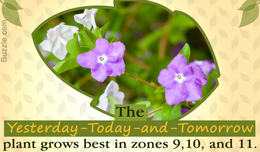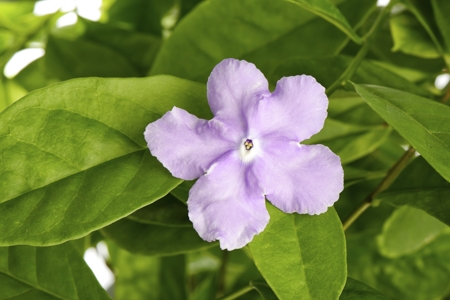The Brunfelsia Pauciflora or yesterday-today-and-tomorrow plant as it is commonly called is a tropical plant indigenous to Brazil. These flowers flaunt a fascinating bed of flowers. Buzzle tells you how to grow and care for your yesterday-today-and-tomorrow plant. Read on!

Watch Out!The
yesterday-today-and-tomorrow plant contains poisonous alkaloids, which are really harmful, especially for small children and pets. Be highly cautious before you consider planting this shrub in your garden.
Brunfelsia pauciflora or
yesterday-today-and-tomorrow is a species of flowering plant belonging to Solanaceae plant family. It is a shrub or small tree that blossoms in the late season. This plant is native to the rainforests of Brazil and can be grown in cooler climatic conditions. It exhibits a charming flower bed in shades of purple, lavender, and white. Plant them in your garden or in containers in your patio, these pretty flowers will surely make everybody's heads turn in awe. These flowers give off a mesmerizing fragrance throughout the blooming season. How Did Yesterday-Today-and-Tomorrow Plant Get Its Name?These showy flowers truly live up to their names. Brunfelsia pauciflora got its common name from its blooms. These flowers last for three days and change colors each day. On the first day, they are purple (Yesterday), the second day they change their color to lavender (Today), and on the third day it changes to white color (Tomorrow). The blooms are noticeable because of the color transformations in three days. You can easily make out whether bloom is yesterday, today, or tomorrow by just looking at their colors. This flower starts blooming in the summer months and lasts till September or October, which is what makes it a more desirable one.
The other common names given to this flower are
Morning-Noon-and-Night, Kiss-me-quick, and
Brazil Raintree.More About Yesterday-Today-and-Tomorrow
Common Name:
Yesterday-Today-and-Tomorrow
Botanical Name:
Brunfelsia Pauciflora
Family:
Solanaceae
Origin:
Brazil Rainforests
Plant type:
Shrub
Growth Rate:
Moderate
Height:
5-8 feet tall
Spread:
4-6 feet wide
Foliage:
Green
Color:
Purple, Lavender, White
Blooms:
Spring
Attributes:
Fragrant, Showy► It is a bushy and spreading evergreen shrub that grows up to three meters in height and two meters wide.
► It has small, fragrant flowers in clusters of 1-3.
► The flowers give off sweet aroma when blooming.
► The foliage is green and dense.
► The leaves have a leathery texture.
► This plant grows best in zones 9, 10, and 11, and also in cooler climates when grown in containers.Growing Yesterday-Today-and-Tomorrow

This plant is not that difficult to grow and care as long as their needs are met. These beauties look the best during spring, but also bloom occasionally during other seasons.
- Select a proper planting location at least five feet away from walls or other plants, and dig a hole twice the base of the plant.
- Make sure you cover all the roots with the soil.
- Water your plant properly and keep it moist (not watery).
- Prune your plant in spring and early days of the fall season. They can grow up to 10 feet tall, but pruning it back to three feet is advisable for those having small gardens.
- They grow best in the areas with rainfall and partial shade, as they do not enjoy extreme heat or extreme cold with frost conditions.
- The soil suitable for them to grow should be slightly acidic. If you do not have acidic soil, then fertilizer for acidic plants will suffice to grow this plant. The pH value should be a neutral 7.
- The soil should be rich and moist. It should hold the moisture without getting hard or too muddy. The moisture gets retained and will flow through the soil. The best way to make a soil loamy is to mix silt, organic materials, and sand in it.
- This plant needs to be kept moist. Make sure you don't overwater it. Whenever you water the plant, if it doesn't seep into the soil within 10-15 seconds, then make sure you stop watering. It might cause the leaves to become yellowish and eventually die.
- This plant thrives in humid and heat conditions. You can even create artificial conditions to grow the plant indoors.
Growing in Containers
If you happen to live in a cooler climate, this plant can be grown in containers. These plants will look the best and ideal for a patio area or an entryway. They need to be taken indoor if the weather is too cold or there's a possible climatic threat of frost. You will need to prune them to keep it smaller. However, it won't affect their rich blooms and fragrance.How to Care?► Water the plant regularly to avoid the soil from getting completely dry, especially during hot weather.
► Fertilize the plant once a year during spring.
► It can easily be propagated by cutting the tips of growth of current season.
► Pruning after the flowering phase will keep your plant bushy.
► Watch out for some deficiency if you notice them turning yellowish.What You Need to Watch Out For?Without a doubt, these flowers are pretty and sweet-smelling, but they do have a dark side. They contain poisonous alkaloids that may cause harm to small children or pets who might get tempted to smell or taste them. The seeds from the flowers are highly poisonous and the berries that they produce are toxic. This may not be a good option for those having pets and small children in their family. Caution and extra care should be taken in case you decide to plant these. Consult a doctor or vet immediately if ingested by your child or pet. If ingested by cats and dogs, the possible symptoms to watch out are:
- Vomiting
- Anxiety
- Difficulty in walking
- Seizures
- Muscle tremors
These evergreen shrubs are a popular choice for garden. They look great in mixed shrub hedges or even along the wall. Use these flowers to your advantage to plant them near the window or veranda and watch your flowers pop in purple, lavender, and white colors on and off throughout the year. They provide a perfect view if complemented with low-growing flowers. Make your garden or patios welcoming and burst with beautiful colors.






 Watch Out!The yesterday-today-and-tomorrow plant contains poisonous alkaloids, which are really harmful, especially for small children and pets. Be highly cautious before you consider planting this shrub in your garden.Brunfelsia pauciflora or yesterday-today-and-tomorrow is a species of flowering plant belonging to Solanaceae plant family. It is a shrub or small tree that blossoms in the late season. This plant is native to the rainforests of Brazil and can be grown in cooler climatic conditions. It exhibits a charming flower bed in shades of purple, lavender, and white. Plant them in your garden or in containers in your patio, these pretty flowers will surely make everybody's heads turn in awe. These flowers give off a mesmerizing fragrance throughout the blooming season. How Did Yesterday-Today-and-Tomorrow Plant Get Its Name?These showy flowers truly live up to their names. Brunfelsia pauciflora got its common name from its blooms. These flowers last for three days and change colors each day. On the first day, they are purple (Yesterday), the second day they change their color to lavender (Today), and on the third day it changes to white color (Tomorrow). The blooms are noticeable because of the color transformations in three days. You can easily make out whether bloom is yesterday, today, or tomorrow by just looking at their colors. This flower starts blooming in the summer months and lasts till September or October, which is what makes it a more desirable one.
Watch Out!The yesterday-today-and-tomorrow plant contains poisonous alkaloids, which are really harmful, especially for small children and pets. Be highly cautious before you consider planting this shrub in your garden.Brunfelsia pauciflora or yesterday-today-and-tomorrow is a species of flowering plant belonging to Solanaceae plant family. It is a shrub or small tree that blossoms in the late season. This plant is native to the rainforests of Brazil and can be grown in cooler climatic conditions. It exhibits a charming flower bed in shades of purple, lavender, and white. Plant them in your garden or in containers in your patio, these pretty flowers will surely make everybody's heads turn in awe. These flowers give off a mesmerizing fragrance throughout the blooming season. How Did Yesterday-Today-and-Tomorrow Plant Get Its Name?These showy flowers truly live up to their names. Brunfelsia pauciflora got its common name from its blooms. These flowers last for three days and change colors each day. On the first day, they are purple (Yesterday), the second day they change their color to lavender (Today), and on the third day it changes to white color (Tomorrow). The blooms are noticeable because of the color transformations in three days. You can easily make out whether bloom is yesterday, today, or tomorrow by just looking at their colors. This flower starts blooming in the summer months and lasts till September or October, which is what makes it a more desirable one. This plant is not that difficult to grow and care as long as their needs are met. These beauties look the best during spring, but also bloom occasionally during other seasons.
This plant is not that difficult to grow and care as long as their needs are met. These beauties look the best during spring, but also bloom occasionally during other seasons.